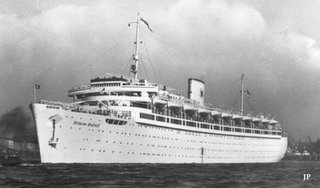Hannibal.

This is coolbert:
Sandwiched between the modern countries of Lithuania and Poland is the political and geographic anomaly of Kaliningrad. The capital city is also Kaliningrad. Part of the Russian Federation. Used to be known as East Prussia [capital city was known as Konigsberg]. Until the end of World War Two [WW2] had a presence of ethnic Germans that thrived and prospered as a community for almost one thousand years. This was an area along the Baltic that had great emotional value to the German population. Indeed, the whole pretext for the start of WW2 was for the Germans to be given by the Poles the Danzig corridor connecting Germany proper to the ethnic enclave of East Prussia.
The February 2005 issue of National Geographic has an excellent article dealing with the little known but portentous events that occurred in the Baltic off the coast of East Prussia in the latter days of WW2.
These events included the greatest maritime evacuation in history, and the greatest maritime disasters in history.
In January, 1945, just prior to the defeat of Germany, Soviet forces trapped enormous numbers of Germany army troops and civilians within the East Prussia area. Cut off from escape by land, sea evacuation was still possible. The Germans put into effect "Hannibal", the maritime evacuation operation. The object was to evacuate as many German troops and civilians as could be done before Soviet troops totally overran the East Prussian enclave.
And "Hannibal" was successful. Became the greatest maritime evacuation in history. Over 2 1/2 million German troops and civilians were evacuated. Compared to Hannibal, the evacuation of 300,000 British troops at Dunkirk is a nothing.
[Hannibal stands in contrast to the relatively poor performance of German naval forces in both World Wars. Toward the middle part of WW2, Hitler himself berated his Admirals for the poor performance of the German Navy, curtly dismissing their abilities and record [the submarine force notwithstanding].
This evacuation was not without cost. On three occasions, Soviet submarines torpedoed and sank transport vessels of Hannibal that were just terribly overcrowded. These ships were the Gustloff [9,000 dead], the Goya [7,000 dead], and the Steuben [5,000 dead]. These civilian transports, not suited for military operations but used nevertheless, sank with such rapidity that there were almost no suvivors among the refugees, soldiers, and wounded [priority was always given to wounded troops] aboard. Civilian maritime disasters, such as the Titanic [1,500 dead], the Empress of Ireland [1,100 dead], and the Eastland [1,000 dead] pale into comparison with the former sinkings of the German transports.
The survivors from these sinkings were few. Those did that survive remember a mass panic as people tried to get off the ship and into the water [the water was just at the freezing point, chances of surviving were almost nil]. And gunshots. Survivors report hearing gunshots from within the ship. These were wounded troops committing suicide. Either the wounded had sidearms of had retained their weapons and decided that there was no hope and quick death by gunshot was preferred to slow death by drowning. This has been mentioned before as what occurs in war when soldiers find themselves in an irreversible, irreedemable situation. Death by suicide is sometimes to be preferred.
coolbert.

0 Comments:
Post a Comment
Subscribe to Post Comments [Atom]
<< Home